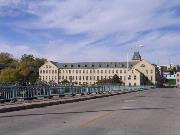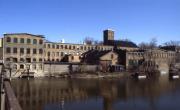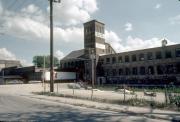Property Record
406 S OLDE ONEIDA ST
Architecture and History Inventory
| Historic Name: | FOX RIVER MILL |
|---|---|
| Other Name: | FOX RIVER MILLS |
| Contributing: | Yes |
| Reference Number: | 38953 |
| Location (Address): | 406 S OLDE ONEIDA ST |
|---|---|
| County: | Outagamie |
| City: | Appleton |
| Township/Village: | |
| Unincorporated Community: | |
| Town: | |
| Range: | |
| Direction: | |
| Section: | |
| Quarter Section: | |
| Quarter/Quarter Section: |
| Year Built: | 1892 |
|---|---|
| Additions: | |
| Survey Date: | 1991 |
| Historic Use: | mill |
| Architectural Style: | Italianate |
| Structural System: | |
| Wall Material: | Brick |
| Architect: | E.D. JONES |
| Other Buildings On Site: | |
| Demolished?: | No |
| Demolished Date: |
| National/State Register Listing Name: | Fox River Paper Company Historic District |
|---|---|
| National Register Listing Date: | 4/19/1990 |
| State Register Listing Date: | 1/23/1990 |
| National Register Multiple Property Name: |
| Additional Information: | A 'site file' exists for this property. It contains additional information such as correspondence, newspaper clippings, or historical information. It is a public record and may be viewed in person at the Wisconsin Historical Society, Division of Historic Preservation. Additional map codes are: FCS9/24-29 10/29. Additional photo codes are: FCS 9/24-29. Related bulidings: OU 29/9, 10. FCS 9/24 - RIVERSIDE COMPLEX (A) - is a shallow-gabled, four-story, utilitarian mill building at the western, upstream edge of an extended industrial complex. Marked as Building 11, it has an ashlar stone foundation with a water power inlet and sheer brick walls that rise to a corbelled raking cornice. The six bays of its riverside endwall have openings with stone sills, all but one of them segmental-arched. The first story, half a level below the surface of the adjacent, modern bridge, has tie rod plates between three of its wooden-framed windows and the wooden hatch in the bay left of center. In the second story there are short windows and two bays with paired, panelled doors: the second arch from the left, and the square opening right of center. The tall windows of the third story have wooden heads. The four center windows of the fourth story are covered with wooden panels. There is a rectangular slot at the gable apex, and three others evenly spaced along each cornice slope. The foundation power inlet, half-closed by a wooden gate, has a metal-beam lintel. A pair of unencumbered beams protruding from beneath the first-story hatch may have supported a platform next to the train tracks once carried on the nearby metal trestles in the river channel. FCS 9/25 - RIVERSIDE COMPLEX (B) - is a two and a half story utilitarian industrial building, a gabled brick rectangle surrouned by subesquent construction. Roofed with asphalt shingles, it has a corbelled raking cornice with returns. There is a rectangular slot at the gable apex, and five others evenly spaced along each cornice slope. A panel-covered, segmental-arched attic window in the riverside endwall is the only unobscured wall aperture. Two panelled, segmental-arched windows in the second story of the endwall are partly covered by a chain-link storage enclosure at right. A range of windows in the second story of the visible, upstream sidewall has been infilled with brick. At the left of the endwall first story, an enlarged, metal-panelled opening with a metal-beam lintel is obscured by brush and debris. FCS 9/26 - RIVERSIDE COMPLEX (C) - is a two-story utilitarian industrial building, a shallow-gabled brick rectangle with a slightly battered stone foundation. Roofed with asphalt shingles, it has a corbelled raking cornice with a rectangular slot at the gable apex. Four more slots are evenly spaced along each cornice slope. There are nine bays of stone-silled, segmental-arched windows in the riverside endwall: nine wooden-framed windows across the second story, and four taller windows covered with wooden panels in the left bays of the main story. In the downstream sidewall there are twelve narrow bays of stone-silled, segmental-arched windows in both stories. Some first-story windows have been altered to accomodate an enclosed walkway to FCS 9/27, the next building downstream. The vertical wood sheathing, small windows, clerestory roof, and subfloor truss rods of the walkway suggest an origin as a piece of railway rolling stock. This building is also tied to FCS 9/27 by a rooftop pipeline which bisects the manufacturing complex. Inland and upslope, FCS 9/26 abuts the rear wall of FCS 9/29. FCS 9/27 - RIVERSIDE COMPLEX (D) - is a three-story utilitarian industrial building, a shallow-gabled brick rectangle with a cement-plastered foundation. Roofed with asphalt shingles, it has a corbelled raking cornice and nine bays of vertical windows in its riverside endwall. The wooden-framed windows, tallest in the second story, have stone sills and lintels. The right three bays of the first story are obscured by brush, but appear to have no windows. The building is linked to the next upstream, riverside building by a first-story enclosed walkway and a rooftop pipeline. It is linked by a metal-sheathed enclosed walkway descending from a third-story sidewall window to the endwall second story of FCS 9/29, the next upstream, landward building. FCS 9/28 - RIVERSIDE COMPLEX (E) - a three story utilitarian industrial building, this flat-roofed brick rectangle links FCS 9/24 and FCS 9/29. It has a corbelled cornice and twenty-two bays of stone-silled, segmental-arched windows. The first-story windows, covered with panels, are largely blocked by an added cement dock and a metal shed at the upstream right. The right six bays of the second story have been infilled with brick; the next two windows to the left are covered with wooden panels. The rest of the second story, and all of the third-story windows retain their original wooden frames. FCS 9/29 - RIVERSIDE COMPLEX (F) - is a two and one half story utilitarian industrial building, a gabled brick rectangle with an engaged six-story tower at its roadside, upstream corner. Roofed with asphalt shingles, it has corbelled wall and raking cornices. There are six bays of stone-silled, segmental-arched windows in the second story of the sidewall; a metal shed roof supported by three kingpost trusses is attached below their sills. The junctions of the lower truss elements and the first-story wall separate pairs of enlarged openings with metal overhead doors. There are flexible hoods for the right pair of these dock doors. The flat-roofed corner tower has presumably been stripped of a mansard roof, removing a distinct Second Empire accent from the building. The tower has narrow stone-silled, segmental-arched windows: three in rach face of the sixth story, two toward the roadside and one upstream in the fifth story, and in the fourth story, one toward the roadside infilled with brick and two upstream, one infilled with brick and a smaller window at right. The lower upstream stories of the tower are obscured by the abutment of FCS 9/28. There is one window in each of the tower's three lower roadside stories and a ground-story door. Visible above FCS 9/28 is a trio fo round-arched attic windows with a center window twice the height and width of those flanking. The windows are in an irregular extension of the downstream gable that rises to a flat roof deck between the tower and the ridge of the main block. |
|---|---|
| Bibliographic References: | Architecture/History Survey Fox River Bridge Rehabilitation, S. Oneida St. , WisDOT ID#4984-07-00, Prepared by Timothy F. Heggland (July 2011) |
| Wisconsin Architecture and History Inventory, State Historic Preservation Office, Wisconsin Historical Society, Madison, Wisconsin |





